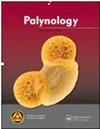芦花科新属Dryades Groppo, Kallunki & Pirani及其系统发育近缘种花粉形态特征
IF 1.3
4区 地球科学
Q3 PALEONTOLOGY
引用次数: 0
摘要
摘要藜科有150 ~ 170属,约有2040种。孔丘属是种数最多的属,受多种性状状态的限制,是一个多态类群。最近的一项研究提出了一个新的属,Dryades,由以前定位在孔乔科的物种形成。本研究旨在描述杉木属植物的花粉形态,并将其与系统发育相关物种的花粉形态进行比较,以提供表征杉木属植物特征的数据。本研究分析了森林树属(Dryades)和Andreadoxa、Angostura、Erythrochiton、galalipea、Rauia和Conchocarpus等8种植物的花粉粒。对花粉粒进行乙酰化、定性测定、描述和定量分析。使用光学显微镜(LM)和扫描电子显微镜(SEM)的插图。进行多变量分析。花粉粒为单株,等极性,中等至很大,近圆形至近三角形,扁球状至长形。孔径为3个或5个,孔径大小不等(从很小到很大)。内孔通常呈沿形,很少呈圆形。所分析的花粉粒有微网状、网状、大网状、网状-小棍状、小棍状或疣状-小棍状。花粉粒的质性和定量特征(特别是孔数、外孔长度、外壁纹饰和花粉粒的大小)对属的区分和属内种的划分具有重要意义。森林树属的花粉形态与相关属(Andreodoxa, galalipea,尤其是Rauia)的相似。森林树的花粉粒形状和花粉孔数与大叶孔木不同。本研究所观察到的花粉资料证实了芸香科花粉的多样性。本文章由计算机程序翻译,如有差异,请以英文原文为准。
Pollen morphology characterization of Dryades Groppo, Kallunki & Pirani, a new genus of Rutaceae, and its phylogenetically related species
Abstract Rutaceae (Sapindales) is represented by approximately 2040 species and 150–170 genera. Conchocarpus is the genus with the highest number of species and is circumscribed by a combination of character states, making it a polymorphic group. A recent study proposed a new genus, Dryades, formed by species formerly positioned in Conchocarpus. This study aims to describe the pollen morphology of Dryades species, comparing it with the palynology of phylogenetically related species, to present data that can characterize the species of Dryades. We analyzed the pollen grains of Dryades species and eight species of the genera Andreadoxa, Angostura, Erythrochiton, Galipea, Rauia and Conchocarpus. The pollen grains were acetolyzed, measured, described qualitatively, and analyzed quantitatively. Illustrations using light microscopy (LM) and scanning electron microscopy (SEM) are presented. Multivariate analysis was performed. The pollen grains are monads, isopolar, medium to very large in size, with subcircular to subtriangular amb, and oblate-spheroidal to prolate shape. The apertures are 3- or 5-colporate, varying in size (very small to very large colpi). The endoapertures are usually lalongate, rarely circular. The pollen grains analyzed are microreticulate, reticulate, macroreticulate, reticulate-baculate, baculate or verrucate-baculate. Both qualitative and quantitative characteristics of pollen grains proved to be important in distinguishing genera and grouping species within genera (in particular, the number of apertures, the length of the ectoaperture, the exine ornamentation and the size of the pollen grains). Dryades species show similarities in pollen morphology to species of related genera such as Andreodoxa, Galipea and especially Rauia. The shape of pollen grains and the number of apertures in Dryades are distinct from those found in Conchocarpus macrophyllus. The pollen data observed in this study confirm the pollen diversity of Rutaceae.
求助全文
通过发布文献求助,成功后即可免费获取论文全文。
去求助
来源期刊

Palynology
地学-古生物学
CiteScore
3.40
自引率
26.70%
发文量
48
审稿时长
>12 weeks
期刊介绍:
Palynology is an international journal, and covers all aspects of the science. We accept papers on both pre-Quaternary and Quaternary palynology and palaeobotany. Contributions on novel uses of palynology, review articles, book reviews, taxonomic studies and papers on methodology are all actively encouraged.
 求助内容:
求助内容: 应助结果提醒方式:
应助结果提醒方式:


